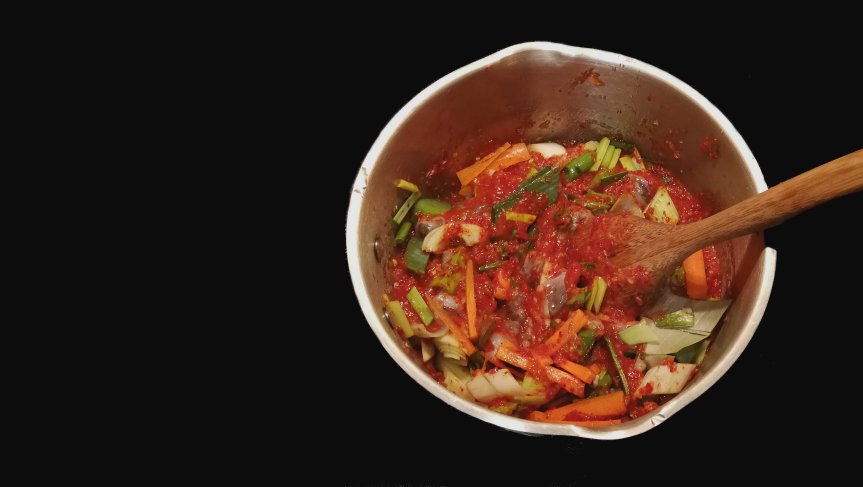Another stop in my fermentation journey.

So I used fermented raw octopus in this kimchi recipe and let me tell you that was a little gross even for me. It’s just that the rest of the kimchi is so colourful and vibrant and then you come across this soft grey glob in the middle of it all that is honestly kind of jarring. But it adds flavour, so give it a try! And so far I’m not dead yet (fingers crossed) so as long as you use fresh, good quality seafood it should be fine.

Kimchi can be expensive to buy if you eat it regularly, especially in the small American town that I live in, so I highly recommend trying to make your own! It’s just such an easy way to add vegetables to your diet, and the sourness from its fermentation is also really good as a side dish to tickle your appetite.

Also every family in Korea seems to have their own recipe and method to make kimchi so it’s really a flexible recipe and you could incorporate elements and ingredients from different recipes to make a kimchi you can call your own.
I just stuck to being an uncreative basic person and followed this recipe though.
Ingredients
Fermented octopus (optional)
- 100g either very fresh octopus or frozen (you can also use squid)
- 1 tbsp salt
Porridge
- 1/3 cup salt (100g)
- 1/6 cup sweet rice flour/glutinous rice flour (chapssal garu or mochiko, about 21g)
- 1/12 cup or 1 1/3 tbsp sugar (about 17g)
Kimchi
- About 3 pounds/1.5kg napa cabbage
- 1/3 cup fish sauce
- 1/2 cup hot pepper flakes/gochugaru (amount up to spice preference)
- 1/3 cup crushed garlic
- 1/2 tbsp minced ginger
- 1/3 cup minced onion
- 3 scallions
- 2/3 cups leek (about 1 leek)
- 2/3 cups Korean radish (if available, I couldn’t find any so I omitted this)
- 1/2 carrot
Method
Salty fermented octopus (prepare the week before kimchi making)
- Clean the octopus (remove the guts) and rinse it.
- Add the tbsp of salt and mix with the octopus.
- Keep the salty octopus in a glass jar in the refrigerator for a week.
- The day of kimchi making, rinse the octopus thoroughly until not slippery and drain.
- Dry the octopus on a paper towel.
- Chop the octopus up into small pieces.
Kimchi
- Remove the discoloured outer leaves of the napa cabbage, if any.
- Cut the cabbage lengthwise into quarters and remove the cores. Chop into bite sized pieces.
- Soak the cabbage pieces in cold water in a large basin. Sprinkle salt into the mixture. (About 1cup salt:10lb cabbage. Basically you want the salt:water ratio high enough that the cabbage will be salty at the end of this process, but also enough water that all the cabbage is in contact with the water). The cabbage is going to release some water so don’t overfill the bowl at the start.
- Every 30 mins, mix the cabbage in the salt water so all the pieces are evenly salted. (While the cabbage is soaking, proceed to make the porridge)
- 1.5 hours later, taste the cabbage to make sure it’s salty. If it’s not, add some more salt and soak 30 mins more.
- Rinse the cabbage in cold water 3 times to clean it thoroughly.
- Drain cabbage well and set aside.
Porridge
- Put 1 cup of water and the sweet rice flour in a pot and mix well. Bring to a boil. Keep stirring until the porridge makes bubbles, about 5 mins.
- Add the sugar and the salt. Stir and cook for a few more minutes until the porridge is translucent.
- Cool the porridge down to room temperature.
Assembly
- Mince the garlic, ginger, and onion into very small pieces using a food processor.
- Place the cooled porridge into a large bowl. Then add the fish sauce, hot pepper flakes, crushed garlic, minced ginger, and mined onion.
- Add the chopped up fermented octopus to the paste (if using).
- Slice the scallions into diagonal shapes and add to the paste.
- Chop the leek into small pieces and add to the paste.
- Julienne the radish and the carrot and add to the paste.
- Mix all the ingredients well.
- Add the cabbage to the kimchi paste and mix by hand (might be helpful to wear disposable gloves so your hand doesn’t become a spice hazard). Make sure that each piece of cabbage is covered well by the paste.
- Put the kimchi into an air-tight container and press down into the container well.
- Leave the kimchi in the fridge. The kimchi will start to ferment after a couple of days and you can tell by the increase in liquid in the container and bubbles will start forming. The longer the kimchi is kept in the fridge, the more sour it gets.
- When you want to use the kimchi, take a bit out and leave in an airtight container at room temperature until it is to a desired sourness. Make sure to press down the remaining kimchi in the container well after taking out some kimchi so that the kimchi doesn’t grow mould/any funny things.
Notes
- The amount of garlic/ginger/onion/carrot/whatever is really up to your personal preference. As I said, it’s quite a flexible recipe.
- The original recipe used salty fermented squid but I used octopus because it was what I could find in my grocery store. Still worked well. But if eating raw seafood grinds your gears this ingredient is entirely optional.
- You could eat the kimchi the day you make it, but I always found it tastes better after you give it some time to ferment.
- The key to good kimchi is that it has to be salty enough! So taste your cabbage along the way.

